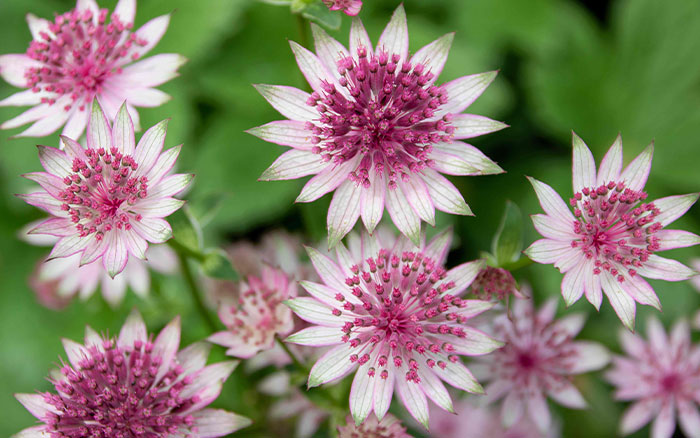These lovely cottage-garden favourites are easy to grow, and add some lovely, delicate colour to garden borders. Find out how to grow Astrantia in my blog.
Plant Biography

BOTANICAL NAME
Astrantia
COMMON NAME
Masterwort, Hattie’s pincushion
NATIVE TO
Mediterranean Europe, Hungary, Iran, Poland, Romania, Switzerland, and Ukraine.
DESCRIPTION
Astrantia or Masterwort is an easy to grow, summer-flowering perennials. A great addition to garden borders, as they work well with grasses or plants known for more spectacular displays.
What type of plant is it?
These summer-flowering plants are perennials.
What colours does Astrantia come in?
Many shades of pink, red, purple, silver, and white.
.




When do these plants flower?
You can expect to see masterwort’s flowers between June and August.
Where does it like to grow?
A sheltered, sunny spot or partial shade is ideal. Astrantia is also happy in moist, well-drained or poorly drained soil.
Where does it dislike to grow?
Exposed positions or being situated in too much shade. Keep them well watered in very hot, dry conditions too.
Is this plant drought-tolerant?
They tend to like moisture in their soil, so are not particularly drought-tolerant. They would require regular mulching and watering in drier soils.
How to grow Astrantia successfully
You can sow the seeds of Astrantia from February to April undercover, and then again in August and September in the garden.
When purchasing Masterwort from a garden centre, you can plant out from October to April. The muted flowers of this plant will be on display from June to August.
To encourage Astrantia to flower again, cut back in March, October, and November.
Mulching the soil every year around your Masterwort will ensure that moisture is retained within the soil, and they won’t dry out.

Do they require supports?
No, this plant won’t gain any benefit from supports.
Is it good for pollinators?
Yes.

Is it good for wildlife?
Besides attracting pollinators, Astrantia is thought to have no further wildlife benefits. However, it is not toxic to pets, horses, livestock, or humans.
.
How to choose the right variety for your garden
Astrantia look great in a variety of garden styles, including cottage/informal, coastal, gravel, patio, and wildlife gardens.

How big will it get
An average height and spread of approximately 40cm x 90cm.
How to plant Astrantia
Dig a hole that is approximately the slightly larger than the pot. Remove the Masterwort from its container and place in the hole. Fill any gaps with soil and firm the plant in well. Remember to water in the plant to help it establish itself.
How to care for Astrantia
Masterwort have a high hardiness rating of H7. This is the means they cope in the coldest parts of Europe. They are low maintenance, just cut back flowers and foliage hard in autumn or spring for continued results.
Astrantia is clump forming so remember to keep on top of division for good plant health. You shouldn’t have to worry about staking the plant.
Do they spread?
It can spread, as it is capable of self-seeding.
How to keep it looking good
Astrantia make great cut flowers and cutting them encourages the plant to produce more flowers.

Does Astrantia need deadheading?
To prolong the flowering period, deadheading masterwort defers energy from seed production into flower production. However, if you want them to self-seed, leave the fading flowerheads to produce seeds later.
Does it need pruning, and when should they be pruned?
The only pruning this plant will benefit from is being cut back once all the flowers have faded.
How to propagate these plants
Lift and divide in spring using a garden fork, then replant or grow on in a container.
What problems can Astrantia have?
Generally, Astrantia are trouble free but can suffer from powdery mildew to avoid this ensure good air circulation is maintained around plants.
Masterwort are susceptible to Astrantia leaf miner. This is a small fly whose larvae feed from within the foliage of the plant. If your plant is affected by this insect, you will notice brown patches on the leaves. Fortunately, the plants will survive and still bloom, even if the impact appears severe.
If you don’t like the look of the leaves that have been impacted by the miner, then you can remove the leaves, or attract natural predators such as parasitic wasps or Blue Tits.
Varieties of Astrantia to have

Astrantia Major Florence, has delightful clusters of pink and lilac flowers. It will have a mature height of 80cm and spread to 45cm.

Astrantia major Alba, with its snow-white flowers matched with the rich green foliage, this will be eye catching addition to your border. Reaching 75cm in height and spreading 50cm when fully mature.

Astranita Moulin Rouge. The pincushion flowers of red, white, and green put on flowering show that is second to none. A great cut flower, they are ideal for summer bouquets. When fully grown they will be 55cm in height and spread to 45cm.
Astrantia Venice, with its rich burgundy-purple flowers this regal looking plant will look great in a cottage garden design. At maturity it will grow to 55cm in height and spread to 45cm.
Best time of year to buy this plant
These plants are available all year round from growers as loose roots. Though keep an eye out for them in garden centres in springtime, just before they start flowering.
The best garden design style for this plant
Thanks to their range of colours, Masterwort look good in many garden styles. Pair more muted shades or whites with brighter flowering plants such as crocosmia or alstroemeria.
Plant alongside Echinops, Echinacea, Verbena bonariensis, and Agastache for really feast for pollinators.
As they make great cut flowers, they are perfect for including in a cutting garden.


Leave A Comment